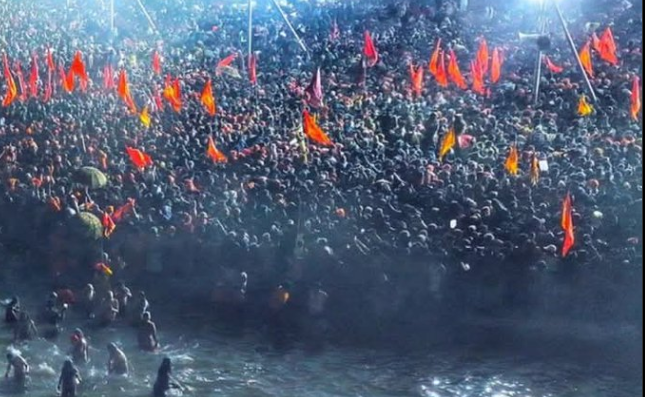By Badal Saroj
The month-long Kumbh Mela has commenced. Particularly, the Kumbh of Allahabad—now officially renamed Prayagraj—stands as the largest gathering on this part of the Earth. This festival, unique in its inclusivity and extraordinary congregation, amazes with the sheer magnitude of its human participation. Jawaharlal Nehru, born in Allahabad, marveled at how millions would arrive at the Ganges without any announcements or advertisements—a testament to a tradition evolving over centuries, becoming an intrinsic part of cultural identity. During Nehru’s time, participation in the millions was considered massive; today, the numbers reach tens of millions and are still rising. This year, claims suggest that around 450 million people—one-third of India’s population—will attend. Though such figures might stretch the truth, it reflects the scale of the event.
The Kumbh seamlessly merges tradition and mythology, forming a cultural and historical continuum despite its religious significance. Held cyclically every three years at Allahabad, Haridwar, Ujjain, and Nashik, the Kumbh Mela has been a space for exchanging news, understanding diverse lifestyles, and engaging in philosophical, religious, and social dialogues. Ancient accounts by visitors like Megasthenes, Faxian, Xuanzang, and Al-Biruni noted this distinctive aspect.
The term “Kumbh Mela” first appeared in the Mughal-era gazette Khulasat-ut-Tawarikh, written during Aurangzeb’s reign. Adi Shankaracharya, influenced by Buddhist traditions, reshaped the event in the 8th-9th century to combat Buddhist dominance with the principle of “Brahma Satyam, Jagat Mithya” and united various Hindu sects through institutions like the Akharas. His efforts took centuries to formalize into the Akhara processions and the royal bath (Shahi Snan), where even the Persian terms Peshwa and Shahi highlight the inclusive evolution of traditions.
Rulers have historically facilitated the Kumbh, with documented evidence of Emperor Akbar initiating public amenities like toilets and ghats, appointing officials for logistics, and allocating state funds. The British and post-independence governments continued this tradition, with modern budgets dedicated to infrastructure.
The Kumbh’s Distortion in 2025
The rich history of inclusivity and continuity is now overshadowed by political motives and a divisive agenda. For the 2025 Mahakumbh, the essence of the event has been overshadowed by a grotesque politicization. Instead of preserving traditions, the event has been distorted. The city of Prayagraj and its surroundings are adorned with colossal hoardings of Prime Minister Modi and Chief Minister Yogi Adityanath. From advertisements to media coverage, their imagery dominates, reducing this grand gathering into a propaganda tool.
The divisive tone was set even before the Mela began. Ravindra Puri, the politically backed President of the Akhara Parishad, made inflammatory remarks about strengthening Hindutva under Modi’s leadership, labeling opposition parties as anti-Hindu, endorsing RSS chief Bhagwat’s controversial “four children” statement, and calling for the conversion of mosques into temples. Puri also demanded that Muslims be barred from renting shops at the Mela. This bigotry escalated with calls to ban Muslims and non-Hindus from participating, supported by BJP leaders like Kailash Vijayvargiya and Sangeet Som.
Chief Minister Adityanath added fuel to the fire by stating that only those revering Sanatan traditions should attend the Mela, alienating non-Hindus and even sections within Hinduism. Ironically, Adityanath belongs to the Nath sect, historically opposed to Brahminical traditions. His statement was echoed by Jyotirmath’s Shankaracharya, who explicitly barred Arya Samaj members from attending.
Hypocrisy and Commercialization
While small vendors and hawkers faced scrutiny, corporate interests were embraced. The arrival of global figures like Apple’s co-founder’s widow, Laurene Powell Jobs, was celebrated. Meanwhile, individuals like rapist Asaram received prominent platforms. Efforts to honor figures like former Chief Minister Mulayam Singh Yadav faced backlash, showcasing the selective morality of the event’s organizers.
Prominent figures such as self-styled religious leader Ram Bhadracharya, an ardent supporter of Modi, took the Kumbh further away from its inclusive roots. Far removed from the humility of historical saints like Kumbhan Das, today’s religious leaders are enmeshed in political power plays.
The Kumbh as a Political Tool
This distortion of the Kumbh Mela reflects a broader trend: using cultural and religious symbols to further a narrow, exclusionary agenda. What once stood as a celebration of cultural diversity and philosophical exchange has been weaponized to propagate communal divisions and political propaganda.
The 2025 Mahakumbh underscores a critical question: can the spirit of inclusivity that has defined this festival for centuries survive its subversion into a platform for hatred and divisiveness? The answer lies in reclaiming the Kumbh as a space for unity, dialogue, and shared heritage.
